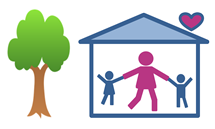
SOUTHGATE MEDALLION TRIBUTE
WELCOME TO OUR APRIL 2022 NEWSLETTER. VOLUME 42, ISSUE 4
SPRING IS FINALLY HERE
Everyone is always excited for a change in seasons especially children! Children get to get rid of their heavy coats, hats, and mittens; however, in Edmonton unpredictable weather can sneak up on us! ☺
Please remind parents to bring clothing and footwear appropriate for the weather.
COORDINATOR'S CORNER
SAVE THE DATE! – Saturday May 21st – 3 pm to 7 pm
Did you know, Southgate Medallion Family Day Home Agency turns 40 this year?!
To celebrate this amazing milestone, and to show our gratitude and appreciation for all the hard work you put in to offering quality care, you are cordially invited to join us for an afternoon of fun, games, networking and food. It’s been too long!
Educator Appreciation/40th Birthday Party.
Where: Woodvale Community Facility
When: Saturday May 21st from 3 pm to 7 pm
Theme: Red and Gold
Further details to follow.
We hope you can join Joyce, Carole, the directors, and agency staff.
Emma,
Coordinator
WELCOME TO NEW EDUCATORS
EARTH DAY ON APRIL 22nd - SAVE OUR EARTH ♡
How to Support Children in Transition
What are transitions?
Transitions are a natural part of life, and they also serve as vital markers for a child's learning and growth. Transitions are the transitions from one activity, relationship, or location to a new or familiar activity, relationship, or location.
What measures can we employ to assist in the transition?
Creating a peaceful smooth transition and environment.
Make as little transitions for the child as necessary. Limiting the number of transitions decreases stress and helps the child maintain a peaceful environment.
Prepare the child for upcoming changes by explaining what will occur and following a continuous consistent transition routine. Talk to the child about what's going on while it's occurring, this results in guidance.
During transition periods, provide access to blankets, plush toys, family photos, or pacifiers to help create a calming and comforting environment. This will assist them in learning how to comfort themselves. Hugs and reassuring remarks can be used to show extra affection and connection.
Be there to help the child cope with complicated and stressful transitions. Provide extra reassurance during key times, such as nap/bedtime, mealtimes, daily routines, and family visits. Be ready for a variety of reactions both before and after challenging transitions.
During the transition, a child may require additional physical and emotional assistance. Discuss with the child any emotions they may have before and after. Assist them in putting their sentiments into words. When a child is upset, give him or her additional hugs, comfort, or space.
Children need environments and routines that foster shared endeavors or dedicated time in small groups to form new connections and acquire a sense of stability after a transition. It makes sense to give children with familiar tools and experiences as they move from home to setting, room to room, join another setting, or start school. In order to continue to develop, they need to feel safe and secure, and a warm, stable atmosphere is essential to this sense of belonging. Children will not lose ground in their learning if only minimal adjustments are required. If they have effectively acclimated to the environment, expectations, and routines, they will be more receptive to new thinking and challenges.
Families require time to explore and connect with new environments, as well as opportunities to chat with children about what is familiar and exciting. As soon as parents enter your facility, make sure there are places for them to meet and interact. Encourage children and parents to speak up about their concerns during the transition process.
Provide advance notice of the change and personalized assistance.
Consider transition to be a process rather than a one-time event; plan ahead of time and consider the concerns of children and their families. Make the transition and the children's well-being a priority. Try giving a 10-minute, 5-minute, and 1-minute heads-up that a shift is approaching. Put these reminders in place with the entire class initially, and then provide extra help for those who require it. An example might be an egg timer that is controlled by an individual child. Alternatively, an instructor might inform each kid that a shift is approaching to support them. It is beneficial to provide these reminders in a positive and motivating manner to urge children to move on to the next activity. Focus on language of commonality rather than differentiation; there's a narrow line between intriguing and overwhelming. https://youtu.be/WCT1N8TKpAQ https://youtu.be/WCT1N8TKpAQ
Sing the directions out loud.
Make use of children's interests and play
Children like playing. Make use of their enthusiasm for playing to keep them motivated. Make transitions enjoyable, such as pretending to be aircraft when you come in from the playground or singing a fun clean-up song when it's time to clean up. If a child isn't responding to this transition technique, consider using interest-based assistance and focusing on what interests them. To engage a child, build on a special passion they have, such as dinosaurs, pets, or dance. Play is a child's labor, so approach coverage of new curriculum with equal ingenuity. When we make provisions for their interests or strong schemas, and when we personalize resources, we convey a strong message to children. We're reminding them that they're special to us and that we remember them even when they're not with us, forming new ties in the process.
Bright and colorful visuals appeal to children, and they can be an effective tool for guiding them through transitions. Children can gain a better knowledge of what is expected of them by using a visual reference. Use an explanatory image on a daily schedule to symbolize all the day's exciting activities, then remove the image as you finish each one. When transitioning children to a new activity, show them enticing pictures of what's coming up next and incorporate singing directions. Another strategy is to show the children something they can anticipate and look forward to. Before a transition, utilize a soft toy or a puppet to let them know that it will visit them during the next activity. This should be used to pique their interest. When using the words "first, then" or "now, next," remember to include visuals. "First, we clean up; then, we have circle time," for example.
After transitions, provide specific positive feedback.
It's critical to acknowledge when things go well and to commend both effort and achievement. Note the behaviors you want to see less of, but the ones you want to see more of. This necessitates providing detailed feedback to children in order to reassure them that their transitions are on track and to clearly explain the abilities they must develop.
Creating connections
Parent-professional connections that are strong and courteous set the groundwork for a smooth transition. A genuine discussion with parents provides information to the practitioner, allowing them to expand their ideas and educational experiences within the setting. Relationships with individuals caring for their child provide comfort to parents, while easy, visible interactions between significant adults are immensely soothing to children. Separation anxiety affects both parents and children, and friendly interactions between practitioners and family members can help tremendously in easing this process. Handovers between practitioners must be carefully planned to ensure that children's needs are satisfied, and new bonds are strengthened. We risk losing children's trust, which can lead to a regression in knowledge and understanding if we don't do this. Allowing for special time with a new key person will instill a greater sense of security. This is especially crucial for children in reception and those transitioning to Year 1, as these children still require the reassurance and guidance of a caring adult to achieve positive transitions, and a key person can recognize a child's emotional response to change and respond appropriately. Create a particular time each day for small groups to spend with their important person.
References
https://www.careforkids.com.au/child-care-provider-articles/article/363/six-strategies-to-help-children-transition-through-their-day https://www.careforkids.com.au/child-care-provider-articles/article/363/six-strategies-to-help-children-transition-through-their-day
http://www.eccpct.com/Resources/Service-Providers/Tips-for-Tots/Supporting-Young-Children-with-Transitions/ http://www.eccpct.com/Resources/Service-Providers/Tips-for-Tots/Supporting-Young-Children-with-Transitions/
https://www.teachearlyyears.com/a-unique-child/view/supporting-transitions-in-the-early-years https://www.teachearlyyears.com/a-unique-child/view/supporting-transitions-in-the-early-years
SPRING SOUP RECIPE
Here's a healthy recipe to try during this spring season.
OFFICE CLOSURE
Please note that the office will be closed on Friday, April 15th and Monday, April 18th, 2022 for the Easter weekend.
Please contact the emergency number 780-245-3097 during this time.
Happy Easter!









